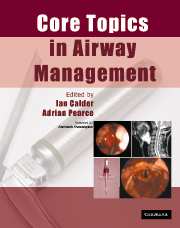Book contents
- Frontmatter
- Contents
- List of contributors
- Preface
- Acknowledgements
- List of abbreviations
- 1 Anatomy
- 2 Physiology of apnoea and hypoxia
- 3 Physics and physiology
- 4 Cleaning and disinfection of airway equipment
- 5 General principles
- 6 Maintenance of the airway during anaesthesia: supra-glottic devices
- 7 Tracheal tubes
- 8 Tracheal intubation of the adult patient
- 9 Confirmation of tracheal intubation
- 10 Extubation
- 11 Light-guided intubation: the trachlight
- 12 Fibreoptic intubation
- 13 Retrograde intubation
- 14 Endobronchial and double-lumen tubes, bronchial blockers
- 15 ‘Difficult airways’: causation and prediction
- 16 The paediatric airway
- 17 Obstructive sleep apnoea and anaesthesia
- 18 The airway in cervical trauma
- 19 The airway in cervical spine disease and surgery
- 20 The aspiration problem
- 21 The lost airway
- 22 Trauma to the airway
- 23 Airway mortality associated with anaesthesia and medico-legal aspects
- 24 ENT and maxillofacial surgery
- 25 Airway management in the ICU
- 26 The airway in obstetrics
- Index
1 - Anatomy
Published online by Cambridge University Press: 15 December 2009
- Frontmatter
- Contents
- List of contributors
- Preface
- Acknowledgements
- List of abbreviations
- 1 Anatomy
- 2 Physiology of apnoea and hypoxia
- 3 Physics and physiology
- 4 Cleaning and disinfection of airway equipment
- 5 General principles
- 6 Maintenance of the airway during anaesthesia: supra-glottic devices
- 7 Tracheal tubes
- 8 Tracheal intubation of the adult patient
- 9 Confirmation of tracheal intubation
- 10 Extubation
- 11 Light-guided intubation: the trachlight
- 12 Fibreoptic intubation
- 13 Retrograde intubation
- 14 Endobronchial and double-lumen tubes, bronchial blockers
- 15 ‘Difficult airways’: causation and prediction
- 16 The paediatric airway
- 17 Obstructive sleep apnoea and anaesthesia
- 18 The airway in cervical trauma
- 19 The airway in cervical spine disease and surgery
- 20 The aspiration problem
- 21 The lost airway
- 22 Trauma to the airway
- 23 Airway mortality associated with anaesthesia and medico-legal aspects
- 24 ENT and maxillofacial surgery
- 25 Airway management in the ICU
- 26 The airway in obstetrics
- Index
Summary
Fine lingerie itself is rather tedious: it is the context that makes it exciting. The same is true for anatomy: topology alone is for idiots-savants. The following lines instead offer a selective account of the functional anatomy of the adult head, neck and airway as it applies to anaesthetic clinical practice.
The mouth
The mouth is dominated by the tongue, a muscular instrument of pleasure – gastronomic and linguistic. For anaesthetists, little else counts but its size. It may be swollen acutely (as in angioneurotic oedema), but is also susceptible to disproportionate enlargement in trisomy 21, myxoedema, acromegaly and glycogen storage diseases, among others.
Angioneurotic oedema can cause such swelling as to fill the entire pharynx, preventing both nasal and mouth breathing and making a percutaneous subglottic airway necessary for survival. Less dramatically, a large tongue (relative to the submandibular space) can hinder direct laryngoscopy. That is, manoeuvered with reasonable force, the laryngoscope blade should squeeze the posterior tongue so as to allow a direct view of the glottis. If the tongue is too large, or the jaw hypotrophied, it may not be possible to see the glottis over the compressed tongue.
Within the mouth, the tongue is like a thrust stage in a theatre. It is surrounded by two tiers of teeth (stalls and royal circle), and a series of trapdoors, wings and flies (Figure 1.1).
Each tooth consists of calcified dentine, cementum and enamel surrounding a cavity filled (if the tooth is alive) with vessels and nerves. Each tooth is held in its socket in the jaw by a periodontal ligament. If a tooth is inadvertently knocked out, the sooner it is returned to its socket the better.
- Type
- Chapter
- Information
- Core Topics in Airway Management , pp. 1 - 8Publisher: Cambridge University PressPrint publication year: 2005



